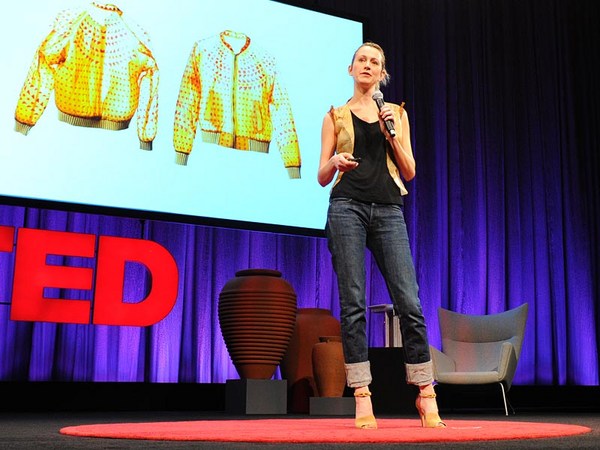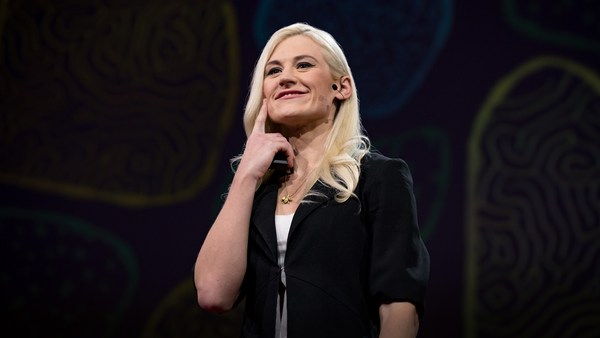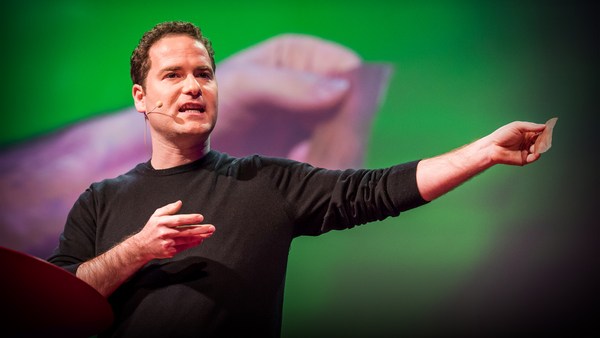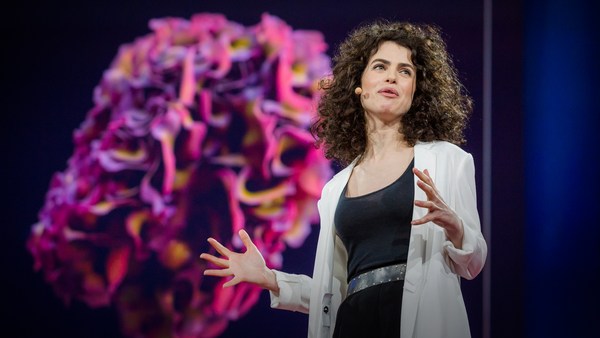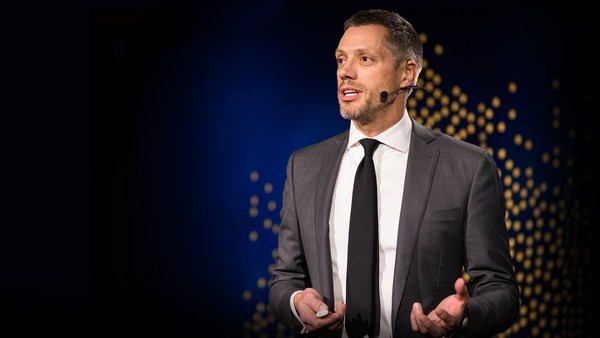You're watching the life cycle of a Streptomyces coelicolor. It's a strain of bacteria that's found in the soil where it lives in a community with other organisms, decomposing organic matter. Coelicolor is a beautiful organism. A powerhouse for synthesizing organic chemical compounds. It produces an antibiotic called actinorhodin, which ranges in color from blue to pink and purple, depending on the acidity of its environment. That it produces these pigment molecules sparked my curiosity and led me to collaborate closely with coelicolor. It is an unlikely partnership, but it's one that completely transformed my practice as a materials designer. From it, I understood how nature was going to completely revolutionize how we design and build our environments, and that organisms like coelicolor were going to help us grow our material future.
So what's wrong with things as they are? Well, for the last century, we've organized ourselves around fossil fuels, arguably, the most valuable material system we have ever known. We are tethered to this resource, and we've crafted a dependency on it that defines our identities, cultures, our ways of making and our economies. But our fossil fuel-based activities are reshaping the earth with a kind of violence that is capable of dramatically changing the climate, of accelerating a loss of biodiversity and even sustaining human conflict. We're living in a world where the denial of this dependence has become deadly. And its reasons are multiple, but they include the privilege of not being affected and what I believe is a profound lack of imagination about how else we could live within the limits of this planet's boundaries.
Fossil fuels will one day give way to renewable energy. That means we need to find new material systems that are not petroleum-based. I believe that those material systems will be biological, but what matters is how we design and build them. They mustn't perpetuate the destructive legacies of the oil age.
When you look at this image, what do you see? Well, I see a highly sophisticated biological system, that through the use of enzymes, can move and place atoms more quickly and precisely than anything we've ever engineered. And we know that it can do this at scale. Nature has evolved over 3.8 billion years to be able to do this, but now through the use of synthetic biology, an emerging scientific discipline that seeks to customize this functionality of living systems, we can now rapid prototype the assembly of DNA. That means that we can engineer the kind of biological precision that makes it possible to design a bacteria that can recycle metal, to grow fungi into furniture and even sequester renewable energy from algae.
To think about how we might access this inherent brilliance of nature -- to build things from living things -- let's consider the biological process of fermentation. I've come to think of fermentation, when harnessed by humans, as an advanced technological toolkit for our survival. When a solid or a liquid ferments, it's chemically broken down by bacterial fungi. The byproduct of this is what we value. So for example, we add yeast to grapes to make wine. Well in nature, these transformations are part of a complex network -- a continuous cycle that redistributes energy. Fermentation gives rise to multispecies interactions of bacteria and fungi, plants, insects, animals and humans: in other words, whole ecosystems. We've known about these powerful microbial interactions for thousands of years. You can see how through the fermentation of grains, vegetal matter and animal products, all peoples and cultures of the world have domesticated microorganisms to make the inedible edible. And there's even evidence that as early as 350 AD, people deliberately fermented foodstuffs that contained antibiotics. The skeletal remains of some Sudanese Nubian were found to contain significant deposits of tetracycline. That's an antibiotic that we use in modern medicine today. And nearly 1500 years later, Alexander Fleming discovered the antimicrobial properties of mold. And it was only through the industrialized fermentation of penicillin that millions could survive infectious diseases. Fermentation could once again play an important role in our human development. Could it represent a new mode of survival if we harness it to completely change our industries?
I've worked in my creative career to develop new material systems for the textile industry. And while it is work that I love, I cannot reconcile with the fact that the textile industry is one of the most polluting in the world. Most of the ecological harm caused by textile processing occurs at the finishing and the dyeing stage. Processing textiles requires huge amounts of water. And since the oil age completely transformed the textile industry, many of the materials and the chemicals used to process them are petroleum based. And so coupled with our insatiable appetite for fast fashion, a huge amount of textile waste is ending up in landfill every year because it remains notoriously difficult to recycle. So again, contrast this with biology. Evolved over 3.8 billion years, to rapid prototype, to recycle and to replenish better than any system we've ever engineered.
I was inspired by this immense potential and wanted to explore it through a seemingly simple question -- at the time. If a bacteria produces a pigment, how do we work with it to dye textiles? Well, one of my favorite ways is to grow Streptomyces coelicolor directly onto silk. You can see how each colony produces pigment around its own territory. Now, if you add many, many cells, they generate enough dyestuff to saturate the entire cloth. Now, the magical thing about dyeing textiles in this way -- this sort of direct fermentation when you add the bacteria directly onto the silk -- is that to dye one t-shirt, the bacteria survive on just 200 milliliters of water. And you can see how this process generates very little runoff and produces a colorfast pigment without the use of any chemicals.
So now you're thinking -- and you're thinking right -- an inherent problem associated with designing with a living system is: How do you guide a medium that has a life force of its own? Well, once you've established the baseline for cultivating Streptomyces so that it consistently produces enough pigment, you can turn to twisting, folding, clamping, dipping, spraying, submerging -- all of these begin to inform the aesthetics of coelicolor's activity. And using them in a systematic way enables us to be able to generate an organic pattern ... a uniform dye ... and even a graphic print.
Another problem is how to scale these artisanal methods of making so that we can start to use them in industry. When we talk about scale, we consider two things in parallel: scaling the biology, and then scaling the tools and the processes required to work with the biology. If we can do this, then we can move what happens on a petri dish so that it can meet the human scale, and then hopefully the architecture of our environments.
If Fleming were alive today, this would definitely be a part of his toolkit. You're looking at our current best guess of how to scale biology. It's a bioreactor; a kind of microorganism brewery that contains yeasts that have been engineered to produce specific commodity chemicals and compounds like fragrances and flavors. It's actually connected to a suite of automated hardware and software that read in real time and feed back to a design team the growth conditions of the microbe. So we can use this system to model the growth characteristics of an organism like coelicolor to see how it would ferment at 50,000 liters.
I'm currently based at Ginkgo Bioworks, which is a biotechnology startup in Boston. I am working to see how their platform for scaling biology interfaces with my artisanal methods of designing with bacteria for textiles. We're doing things like engineering Streptomyces coelicolor to see if it can produce more pigment. And we're even looking at the tools for synthetic biology. Tools that have been designed specifically to automate synthetic biology to see how they could adapt to become tools to print and dye textiles. I'm also leveraging digital fabrication, because the tools that I need to work with Streptomyces coelicolor don't actually exist. So in this case -- in the last week actually, I've just designed a petri dish that is engineered to produce a bespoke print on a whole garment. We're making lots of kimonos.
Here's the exciting thing: I'm not alone. There are others who are building capacity in this field, like MycoWorks. MycoWorks is a startup that wants to replace animal leather with mushroom leather, a versatile, high-performance material that has applications beyond textiles and into product and architecture. And Bolt Threads -- they've engineered a yeast to produce spider-silk protein that can be spun into a highly programmable yarn. So think water resistance, stretchability and superstrength. To reach economies of scale, these kinds of startups are having to build and design and engineer the infrastructure to work with biology. For example, Bolt Threads have had to engage in some extreme biomimicry. To be able to spin the product this yeast creates into a yarn, they've engineered a yarn-making machine that mimics the physiological conditions under which spiders ordinarily spin their own silk.
So you can start to see how imaginative and inspiring modes of making exist in nature that we can use to build capacity around new bio-based industries. What we now have is the technology to design, build, test and scale these capabilities. At this present moment, as we face the ecological crisis in front of us, what we have to do is to determine how we're going to build these new material systems so that they don't mirror the damaging legacies of the oil age. How we're going to distribute them to ensure a sustainable development that is fair and equitable across the world. And crucially, how we would like the regulatory and ethical frameworks that govern these technologies to interact with our society.
Biotechnology is going to touch every part of our lived experience. It is living; it is digital; it is designed, and it can be crafted. This is a material future that we must be bold enough to shape.
Thank you.
(Applause)
